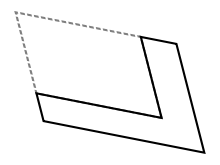
Gnomon
A gnomon ([ˈnoʊmɒn], from Greek γνώμων, gnōmōn, literally: "one that knows or examines") is the part of a sundial that casts the shadow.
The term has come to be used for a variety of purposes in mathematics and other fields.
History
Anaximander (610–546 BC) is credited with introducing this Babylonian instrument to the Greeks.Oenopides used the phrase drawn gnomon-wise to describe a line drawn perpendicular to another. Later, the term was used for an L-shaped instrument like a steel square used to draw right angles. This shape may explain its use to describe a shape formed by cutting a smaller square from a larger one. Euclid extended the term to the plane figure formed by removing a similar parallelogram from a corner of a larger parallelogram. Indeed, the gnomon is the increment between two successive figurate numbers, including square and triangular numbers.
Hero of Alexandria defined a gnomon as that which, when added to an entity (number or shape), makes a new entity similar to the starting entity. In this sense Theon of Smyrna used it to describe a number which added to a polygonal number produces the next one of the same type. The most common use in this sense is an odd integer especially when seen as a figurate number between square numbers.

Gnomon (figure)
In geometry, a gnomon is a plane figure formed by removing a similar parallelogram from a corner of a larger parallelogram; or, more generally, a figure that, added to a given figure, makes a larger figure of the same shape.
Building figurate numbers
Figurate numbers were a concern of Pythagorean mathematics, and Pythagoras is credited with the notion that these numbers are generated from a gnomon or basic unit. The gnomon is the piece which needs to be added to a figurate number to transform it to the next bigger one.
For example, the gnomon of the square number is the odd number, of the general form 2n + 1, n = 1, 2, 3, ... . The square of size 8 composed of gnomons looks like this:
To transform from the n-square (the square of size n) to the (n + 1)-square, one adjoins 2n + 1 elements: one to the end of each row (n elements), one to the end of each column (n elements), and a single one to the corner. For example, when transforming the 7-square to the 8-square, we add 15 elements; these adjunctions are the 8s in the above figure.
Gnomon (journal)
Gnomon. Kritische Zeitschrift für die gesamte klassische Altertumswissenschaft (Gnomon: Critical Journal of the Entire Field of Scholarship on Classical Antiquity) is a German review journal covering the classics. It was established in 1925, first published by Verlag Weidmann and since 1949 by Verlag C. H. Beck. The journal appears in 8 issues each year and contains reviews, obituaries, and notices. Since 1950, odd-numbered volumes contain a "Bibliographic Supplement" of new books, dissertations and submitted journal articles, in addition to the regular contents. The editors-in-chief are Hans-Joachim Gehrke, Martin Hose, Henner von Hesberg, Ernst Vogt, and Paul Zanker.
Abstracting and indexing
The journal is abstracted and indexed in the Arts & Humanities Citation Index and Current Contents/Arts & Humanities. In both 2007 and 2011 the journal received an "INT1" ranking (internationally recognised with high visibility) from the European Reference Index for the Humanities.
Podcasts:
Gnomon
ALBUMS
- Jardim de Ferro released:

-
by No-Man
-
by No-Man
-
by No-Man
-
by No-Man
-
by No-Man
-
by No-Man
-
by No-Man
-
by No-Man
-
by No-Man
-
by No-Man
-
by No-Man
-
by No-Man
-
by No-Man
-
by No-Man
-
by No-Man
-
by No-Man
-
by No-Man
-
by No-Man
-
by No-Man
-
by No-Man
-
by No-Man
-
by No-Man
-
by No-Man
-
by No-Man
-
by No-Man
-
by No-Man
-
by No-Man
-
by No-Man
-
by No-Man
-
by No-Man
-
by No-Man
-
by No-Man
-
by No-Man
-
by No-Man
-
by No-Man
-
by No-Man
-
by No-Man
-
by No-Man
-
by No-Man
-
by No-Man
-
by No-Man
-
by No-Man
-
by No-Man
-
by No-Man
-
by No-Man
-
by No-Man
-
by No-Man
-
by No-Man
-
by No-Man
-
by No-Man
The Break-up For Real
by: No-ManGo back and see the folks,
They're always glad to see you.
Trot out the same old jokes,
Avoid the things that seem new.
No talk about the wife
She lives with someone else now.
Forget your former life,
Warm love became a cold cow.
Driving to the coast,
It's hard to know what hurts the most.
Learning how to feel,
It's the break-up for real.
Go out to see some friends,
You hope that you won't lose it.
You sit there and pretend -
Play adolescent music.
Singing to the sea,
You sing the songs that set you free.
Learning how to feel,
